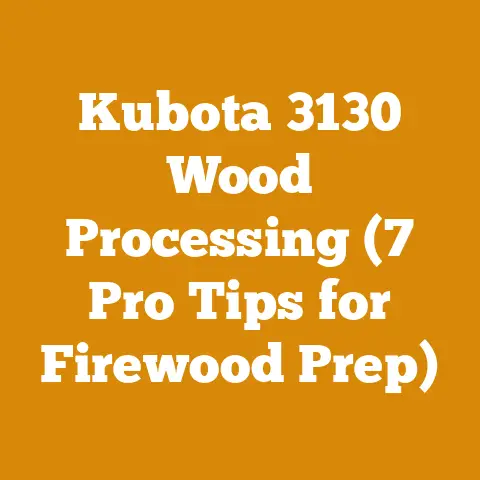Can You Put Pebbles Around Trees? (5 Pro Arborist Tips)
Imagine you’re standing in a forest, sunlight dappling through the leaves.
You see a magnificent oak, its roots spreading wide, and at its base, a neatly arranged circle of… pebbles?
Your first thought might be, “That looks nice!” But then the practical, wood-wise part of your brain kicks in.
“Is that really a good idea?” That, my friends, is the question we’re tackling today: “Can you put pebbles around trees?” And if so, how do you do it right?
I’ve seen well-meaning homeowners inadvertently harm their trees with seemingly harmless landscape choices.
This isn’t just about aesthetics; it’s about the health and longevity of your trees.
So, let’s dive into the 5 Pro Arborist Tips you need to know before you even think about placing those pebbles.
Pebbles Around Trees: A Pro Arborist’s Perspective
The idea of putting pebbles around trees often stems from a desire for a clean, manicured look.
It can seem like a low-maintenance way to suppress weeds and retain moisture.
However, the reality is more nuanced.
While pebbles can offer some benefits, they can also create significant problems if not implemented correctly.
We’re not just talking about aesthetics here; we’re talking about the very lifeblood of your trees.
Key Terms and Concepts
Before we proceed, let’s establish some key terms:
- Root Flare: This is the area where the tree trunk transitions into the root system.
It should always be visible.
Covering it can lead to rot and disease. - Soil Compaction: The process of soil particles being pressed together, reducing pore space and hindering root growth.
- Mulch: Organic material (wood chips, bark, leaves) spread around the base of a tree to retain moisture, suppress weeds, and improve soil health.
- Arboriculture: The cultivation and management of trees.
- Green Wood: Freshly cut wood with a high moisture content.
- Seasoned Wood: Wood that has been allowed to dry, reducing its moisture content.
Crucial for efficient burning in firewood preparation.
5 Pro Arborist Tips for Using Pebbles Around Trees
These aren’t just tips; they’re guidelines I’ve developed through years of observation and hands-on experience.
I’ve seen firsthand the consequences of ignoring these principles, and I’m here to help you avoid those mistakes.
1. The Root Flare is King (and Queen!)
The most crucial aspect of tree health is ensuring the root flare remains exposed.
Burying the root flare, whether with soil, mulch, or, in this case, pebbles, creates a perpetually moist environment that encourages fungal growth and rot.
Imagine trapping your foot in a damp boot all day – that’s what you’re doing to your tree.
Why is this so important?
The root flare is where the tree’s vascular system (the xylem and phloem that transport water and nutrients) is most vulnerable.
Constant moisture weakens the bark and allows pathogens to enter, leading to root and trunk decay.
How to ensure the root flare is exposed:
- Before: Before you even think about adding pebbles, carefully excavate around the base of the tree.
Remove any existing soil or mulch that is covering the root flare. - Identify: The root flare is the widening of the trunk at the base, where the main roots begin to emerge.
- Maintain: Make sure the pebbles are not piled up against the trunk.
Leave a gap of at least a few inches between the pebbles and the trunk.
My Personal Experience: I once consulted on a property where the homeowners had meticulously landscaped around their mature maples, burying the root flares under a thick layer of soil and decorative stone.
The trees were showing signs of decline, with yellowing leaves and reduced growth.
After carefully exposing the root flares, we saw significant improvement in the trees’ health within a year.
2. Consider the Soil Type
The type of soil you have plays a critical role in how well pebbles will work (or not work) around your trees.
- Clay Soil: Clay soil tends to be poorly drained.
Adding pebbles can exacerbate this problem by further reducing aeration and increasing the risk of root rot.
Clay soil has very small particles and tends to compact easily. - Sandy Soil: Sandy soil drains quickly and doesn’t retain moisture well.
Pebbles can help to retain some moisture, but you’ll still need to water regularly. - Loamy Soil: Loamy soil is a mix of sand, silt, and clay and is generally well-drained and fertile.
Pebbles can work well in loamy soil, but it’s still important to monitor moisture levels.
The Science Behind It: Soil texture affects porosity, which is the amount of empty space between soil particles.
This space is crucial for air and water movement, both essential for root health.
What to do:
- Soil Test: Conduct a soil test to determine your soil type and pH level.
This will help you understand your soil’s drainage characteristics and nutrient content.
You can buy a simple test kit at most garden centers or send a sample to a lab for a more detailed analysis. - Amendment: If you have clay soil, amend it with organic matter like compost or well-rotted manure to improve drainage.
If you have sandy soil, add organic matter to improve water retention.
Case Study: I worked on a project where we were planting new trees in an area with heavy clay soil.
Before planting, we amended the soil with a significant amount of compost and incorporated a drainage system to prevent waterlogging.
This ensured the trees had a healthy start and thrived despite the challenging soil conditions.
3. Drainage is Non-Negotiable
Proper drainage is absolutely essential when using pebbles around trees.
If water pools around the base of the tree, it creates a breeding ground for disease and can suffocate the roots.
Why is drainage so important?
Roots need oxygen to survive.
When the soil is waterlogged, the air spaces are filled with water, depriving the roots of oxygen.
This can lead to root rot and ultimately kill the tree.
How to ensure proper drainage:
- Slope: Make sure the ground slopes away from the tree trunk.
This will help to prevent water from pooling around the base. - Drainage System: If you have poorly drained soil, consider installing a drainage system.
This could involve installing drainage pipes or creating a French drain. - Pebble Size: Use larger pebbles that allow for better air circulation and drainage.
Smaller pebbles can compact and restrict water flow.
Tool Specifications: When installing drainage pipes, I often use perforated PVC pipes with a diameter of at least 4 inches.
These pipes are buried in a trench filled with gravel to allow water to drain away from the tree.
My Insight: I’ve found that simply creating a slightly raised bed around the tree can significantly improve drainage, especially in areas with heavy clay soil.
4. Choose the Right Type of Pebble
Not all pebbles are created equal.
The type of pebble you choose can impact drainage, soil temperature, and overall tree health.
- River Rock: Smooth, rounded river rocks are a good choice because they allow for good drainage and air circulation.
- Crushed Stone: Crushed stone can compact more easily and may not provide as good drainage as river rock.
- Colored Stone: Be cautious with colored stones, as some dyes can leach into the soil and potentially harm the tree.
Considerations:
- Size: Choose pebbles that are large enough to allow for good drainage but not so large that they are difficult to work with.
I typically recommend pebbles that are 1-3 inches in diameter. - Color: Opt for natural-colored pebbles to avoid potential chemical contamination.
- Source: Source your pebbles from a reputable supplier to ensure they are clean and free of contaminants.
Data-Driven Decision: A study by the University of California found that using light-colored pebbles can help to reflect sunlight and reduce soil temperature, which can be beneficial in hot climates.
However, dark-colored pebbles can absorb heat and potentially harm the tree’s roots.
5. Weeds Still Exist (and They’re Persistent!)
Pebbles can help to suppress weeds, but they are not a foolproof solution.
Weeds can still grow between the pebbles, and they can be difficult to remove.
Why are weeds a problem?
Weeds compete with trees for water, nutrients, and sunlight.
They can also harbor pests and diseases.
How to control weeds:
- Weed Barrier: Install a weed barrier fabric underneath the pebbles to prevent weeds from growing up from the soil.
Make sure the fabric is permeable to water and air. - Hand-Pulling: Regularly hand-pull any weeds that do manage to grow through the pebbles.
- Herbicides: Use herbicides sparingly and only as a last resort.
Choose herbicides that are specifically formulated for use around trees and follow the instructions carefully.
I generally avoid herbicides as much as possible, preferring manual removal.
Important Note: Avoid using salt-based weed killers around trees, as salt can damage the roots.
My Recommendation: I’ve found that a combination of weed barrier fabric and regular hand-pulling is the most effective way to control weeds around trees.
Beyond the Basics: Advanced Considerations
Now that we’ve covered the core principles, let’s delve into some more advanced considerations that can further enhance the health and aesthetics of your trees.
The Role of Mulch
While pebbles can offer some benefits, they should never completely replace mulch.
Mulch provides numerous benefits that pebbles simply cannot replicate.
- Organic Matter: Mulch decomposes over time, adding organic matter to the soil and improving its structure and fertility.
- Nutrient Release: As mulch decomposes, it releases nutrients into the soil, feeding the tree.
- Soil Temperature Regulation: Mulch helps to insulate the soil, keeping it cooler in the summer and warmer in the winter.
My Strategy: I often recommend using a combination of mulch and pebbles.
Apply a layer of organic mulch around the base of the tree, leaving a gap around the trunk to prevent rot.
Then, surround the mulch with a layer of pebbles for a clean, decorative look.
Wood Type Selection: When using wood chips as mulch, avoid using green wood.
Green wood chips can deplete nitrogen from the soil as they decompose.
Seasoned wood chips are a better choice.
The Aesthetics of Pebbles
While tree health is paramount, aesthetics are also important.
Here are some tips for using pebbles to create a visually appealing landscape.
- Color Coordination: Choose pebbles that complement the color of your house and other landscape elements.
- Texture: Mix different sizes and textures of pebbles for a more interesting look.
- Edging: Use edging to create a defined border between the pebbles and the surrounding lawn or garden.
My Artistic Approach: I often use pebbles to create a dry creek bed effect around trees, mimicking the natural drainage patterns of the landscape.
Chainsaws and Tree Care: A Word of Caution
While I’m a huge advocate for using chainsaws for firewood preparation and logging, they should be used with extreme caution around trees, especially when you’re trying to maintain their health.
- Avoid Root Damage: Never use a chainsaw to cut roots unless absolutely necessary.
Root damage can weaken the tree and make it more susceptible to disease. - Professional Pruning: Pruning should be done by a qualified arborist who understands tree physiology and proper pruning techniques.
- Safety First: Always wear appropriate safety gear, including a helmet, eye protection, hearing protection, and gloves when using a chainsaw.
Chainsaw Specifications: When pruning small branches, I typically use a lightweight chainsaw with a 14-inch bar.
For larger branches, I use a more powerful chainsaw with an 18-inch bar.
Firewood Preparation and Tree Health
The way you prepare firewood can also impact tree health.
- Sustainable Harvesting: Only harvest firewood from trees that are dead, dying, or diseased.
- Proper Felling Techniques: Use proper felling techniques to avoid damaging surrounding trees.
- Seasoning: Season firewood properly to reduce its moisture content and improve its burning efficiency.
Felling Techniques: When felling a tree, I always use a directional felling technique to ensure the tree falls in the desired direction.
This involves making a notch cut on the side of the tree facing the direction of fall and then making a back cut on the opposite side.
Drying Methods: I prefer to air-dry firewood in a well-ventilated area for at least six months.
This reduces the moisture content to below 20%, which is ideal for burning.
Log Splitters: For splitting firewood, I use a hydraulic log splitter.
This makes the job much easier and safer than using an axe.
Case Studies: Real-World Examples
Let’s look at a few case studies to illustrate how these principles apply in practice.
Case Study 1: The Over-Mulched Maple
A homeowner contacted me because their mature maple tree was showing signs of decline.
Upon inspection, I found that the root flare was buried under a thick layer of mulch.
The mulch had created a perpetually moist environment that was promoting fungal growth and rot.
Solution: I carefully removed the excess mulch, exposing the root flare.
I also improved drainage around the base of the tree by creating a slightly raised bed.
Within a year, the tree showed significant improvement in its health.
Case Study 2: The Pebble-Covered Pine
A business owner had installed a layer of pebbles around the base of several pine trees in their parking lot.
The pebbles were small and compacted, preventing water from draining properly.
The trees were showing signs of stress, with yellowing needles and reduced growth.
Solution: I removed the compacted pebbles and replaced them with larger river rocks.
I also installed a drainage system to ensure proper water flow.
The trees gradually recovered and regained their health.
Case Study 3: The Weed-Infested Oak
A homeowner had installed pebbles around the base of their oak tree, but they had not installed a weed barrier fabric.
As a result, weeds were growing profusely between the pebbles, competing with the tree for water and nutrients.
Solution: I removed the pebbles and installed a weed barrier fabric.
I then replaced the pebbles and regularly hand-pulled any weeds that managed to grow through.
The tree thrived after the weeds were controlled.
Practical Next Steps
Ready to put these tips into action?
Here’s a step-by-step guide to help you get started:
- Assess Your Trees: Carefully inspect the base of your trees to ensure the root flare is exposed.
- Test Your Soil: Conduct a soil test to determine your soil type and pH level.
- Improve Drainage: If necessary, improve drainage around the base of your trees.
- Choose the Right Pebbles: Select pebbles that are the right size, color, and texture for your landscape.
- Install a Weed Barrier: Install a weed barrier fabric underneath the pebbles to prevent weeds from growing.
- Apply the Pebbles: Carefully apply the pebbles around the base of the tree, leaving a gap around the trunk.
- Maintain Your Landscape: Regularly inspect your trees and landscape to ensure they are healthy and thriving.
Strategic Insights
Remember, using pebbles around trees is not a one-size-fits-all solution.
It’s important to consider the specific needs of your trees and the characteristics of your soil.
By following these pro arborist tips, you can create a beautiful and healthy landscape that will thrive for years to come.
Conclusion
So, “Can you put pebbles around trees?” The answer is a qualified yes.
You can, but you need to do it right.
It’s about understanding the delicate balance of nature and working with it, not against it.
I’ve seen too many well-intentioned efforts backfire, causing more harm than good.
But with the right knowledge and approach, you can create a visually appealing and healthy environment for your trees.
Now, armed with these 5 Pro Arborist Tips, go forth and landscape responsibly!
And remember, when in doubt, consult with a certified arborist.
Your trees will thank you.






